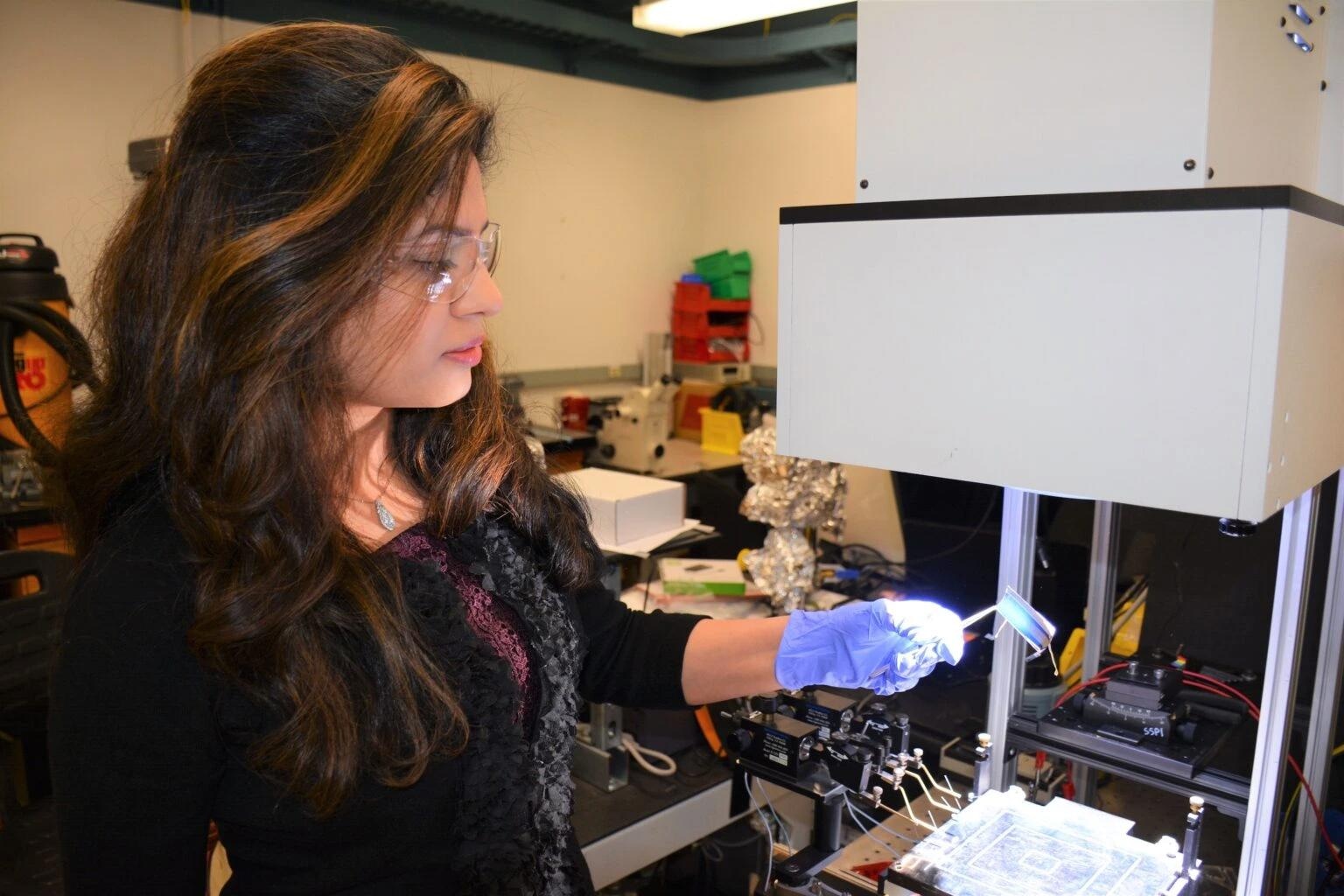In a world searching for green energy solutions from production to storage solar technologies, solar panels are often quickly thrown into the conversation. Despite all of the cutting-edge advances and breakthroughs in solar power, such as longer-lasting photovoltaic cells (PV) to cells that can be printed directly onto substrates, one of the main issues that still baffles scientists is how the energy can be effectively harvested from sunlight at different points in the day.
 Image Credit: Stanford University, Courtesy Nina Vaidya
Image Credit: Stanford University, Courtesy Nina Vaidya
It is well-documented that solar panels are most effective when in direct contact with sunlight. For this reason, many industrial PV systems track the sun’s movement throughout the day. However, solar arrays that move with the sun throughout the day can be expensive as they are more difficult to construct and maintain than stationary arrays.
However, engineering researcher Nina Vaidya of Stanford University has designed a sophisticated device that can harvest and concentrate light efficiently, no matter what the angle and frequency of the light.
Vaidya’s work was published in the journal Microsystems and Nanoengineering, which reports details on the working prototypes of the optical concentrator, which is a simple, graded-index-lens for harvesting sunlight that is inexpensive, design-flexible, and scalable for widespread use.
“It’s a completely passive system – it doesn’t need energy to track the source or have any moving parts,” said Vaidya, who is now an assistant professor at the University of Southampton, UK. “Without optical focus that moves positions or need for tracking systems, concentrating light becomes much simpler,” she continued.
Simple, Elegant and AGILE
The optical concentrator, which is remarkably simple and elegant in terms of design, is known as AGILE – which stands for Axially graded Index lens. When inverted, it looks something like a pyramid with a flattened top and is able to capture over 90% of the light that hits its surface. The geometry of the AGILE pyramid is made up of various sizes of flat index graded glass which are stacked on top of one another and bonded together.

Image Credit: Stanford University, Nina Vaidya
Light can enter the larger surface of the optical concentrator from any angle as the refractive indexes of the glass stacks then channel the light to create a brighter spot near the output. When installed as a layer on top of solar PV cells, AGILE optical concentrators have the capacity to capture both direct sunlight and diffuse light that has been scattered by the Earth’s atmosphere, weather, and seasons.
Moreover, a surface layer of AGILE optical concentrators that replaces current encapsulation apparatus would remove the need for complex, moving systems that track the sun throughout the day and reduce any associated costs with manufacturing and maintenance.
We wanted to create something that takes in light and concentrates it at the same position, even as the source changes direction. We don’t want to have to keep moving our detector or solar cell or moving the system to face the source.
Nina Vaidya, Stanford University
AGILE could even generate cost savings due to the fact the optical concentrators are relatively cheap to fabricate, and fewer of them would be needed to meet energy harvesting requirements.
Better Solar Concentrators
The premise of AGILE is similar to using a magnifying glass to collect and concentrate the sun’s energy into a small focal point of heat and light. However, the lens of the magnifying glass usually has to be moved in line with the sun’s position. AGILE lenses, however, can collect the sunlight and concentrate it without having to be consistently moved throughout the day.
Vaidya, supported by her supervisor Olav Solgaard, Stanford professor of electrical engineering, developed the theory that direct and diffused light could be collected and concentrated using a material engineered in a way that gradually increased in refractive index, which would cause the light to bend towards a narrow focal point.
One of the next challenges was finding which material would work best for the AGILE optical concentrators. Vaidya and Solgaard tested a series of commercial-grade glasses and polymers with refractive indexes and applied new fabrication techniques to develop a working prototype.
The stacks made up of varying glass flats and polymers demonstrated the ability to concentrate energy equivalent to that of “3 suns,” the researchers claim.
To be able to use these new materials, these new fabrication techniques, and this new AGILE concept to create better solar concentrators has been very rewarding. Abundant and affordable clean energy is a vital part of addressing the urgent climate and sustainability challenges, and we need to catalyze engineering solutions to make that a reality.
Nina Vaidya, Stanford University
AGILE optical concentrators also have additional application potential beyond clean energy production and storage in areas such as light management, laser coupling, display technologies and even in outer space, protecting equipment and devices from solar radiation.
References and Further Reading
Castsñón, L., (2022) New optical device could help solar arrays focus light, even under clouds | Stanford News. [online] Stanford News. Available at: https://news.stanford.edu/2022/06/27/new-optical-device-help-solar-arrays-focus-light-even-clouds/
Vaidya, N. and Solgaard, O., (2022) Immersion graded index optics: theory, design, and prototypes. Microsystems & Nanoengineering, [online] 8(1). Available at: https://www.nature.com/articles/s41378-022-00377-z
Disclaimer: The views expressed here are those of the author expressed in their private capacity and do not necessarily represent the views of AZoM.com Limited T/A AZoNetwork the owner and operator of this website. This disclaimer forms part of the Terms and conditions of use of this website.